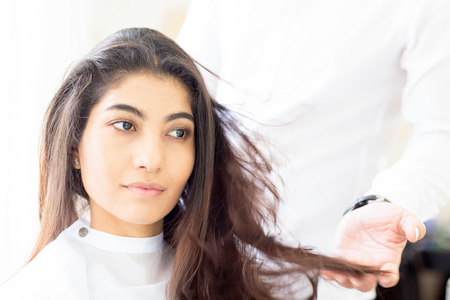Understanding Indian Hair Types and Colouring Effects
When it comes to hair care in India, we know every head is unique—just like our food, languages, and traditions! Indian hair generally comes in a variety of textures, ranging from silky straight strands in the North to luscious waves and thick curls down South. Many of us have dense, coarse hair that’s naturally strong, but frequent colouring or styling can take a toll even on the toughest locks. The chemicals in hair dyes can sometimes strip away natural oils, making our beautiful manes feel dry or look thinner than before. Especially with popular styles like highlights, global colouring, or even a simple henna touch-up, it’s important to understand how these treatments interact with our individual hair types. If you have fine or wavy hair, colouring might lead to more noticeable thinning or breakage compared to someone with thicker strands. That’s why recognising your own hair’s texture—and how it reacts to colour—is the first step to keeping it thick and healthy. Whether you’re getting ready for a family function or just want to try something new for yourself, knowing your roots (literally!) helps you make better choices for vibrant and strong tresses.
2. Traditional Indian Oils for Post-Colour Hair Care
After colouring and styling, our hair often feels dry, frizzy, and lacks that thick, lustrous bounce we all love. In India, generations have trusted natural oils to restore hair health and keep it looking fabulous. Let’s talk about three superstar oils—coconut oil, amla oil, and almond oil—and how you can use them to nourish your colour-treated hair at home.
Coconut Oil: The Timeless Classic
Coconut oil is a staple in every Indian household, and for good reason! It deeply penetrates the hair shaft, reduces protein loss, and keeps your strands strong. For post-colour care, warm up some coconut oil and massage it gently into your scalp and hair lengths. Leave it overnight or for at least one hour before washing. This simple ritual helps lock in moisture and brings back shine without stripping away your new hair colour.
Amla Oil: The Ancient Strengthener
Amla, or Indian gooseberry, is packed with Vitamin C and antioxidants. Regular amla oil massages can help maintain hair thickness even after multiple rounds of colouring and heat styling. Its cooling properties soothe the scalp, reduce breakage, and promote natural regrowth—perfect for anyone worried about thinning hair post-treatment.
Almond Oil: Lightweight Nourishment
If you’re looking for something non-greasy yet nourishing, almond oil is your go-to. Rich in Vitamin E and essential fatty acids, almond oil repairs damage from within while keeping hair soft and manageable. Gently apply a small amount on damp hair after washing or use it as a leave-in serum to tame frizz caused by colouring chemicals.
Quick Comparison of Indian Hair Oils for Coloured Hair
| Oil Type | Main Benefit | How to Use | Best For |
|---|---|---|---|
| Coconut Oil | Deep hydration & strength | Warm massage before wash | Dry, brittle hair |
| Amla Oil | Thickening & growth boost | Scalp massage 1-2 times a week | Thinning or weak roots |
| Almond Oil | Smoothness & repair | Apply on damp or styled hair | Frizzy or dull ends |
Pro Tips for Maximum Results:
- Always do a patch test before using any new oil if you have sensitive skin.
- Mix a few drops of essential oils like rosemary or lavender with your base oil for added benefits.
- Avoid harsh shampoos after oiling; opt for sulphate-free formulas common in Indian markets.
- Add a steaming towel wrap after applying oils to help nutrients penetrate better.
- Consistency is key—make these oils part of your weekly self-care routine!
Tapping into these traditional Indian remedies not only protects your coloured tresses but also celebrates our rich heritage of holistic beauty care. Try them out and let your hair do the talking—naturally thick, shiny, and full of life!

3. Herbal Remedies and Natural Masks
When it comes to keeping your hair thick and healthy after all the colouring and styling, nothing beats the age-old wisdom of Indian herbal remedies. Our grandmothers always trusted natural ingredients, and these home recipes are still popular from Mumbai to Chennai! Let’s dive into some classic DIY masks using henna, curd, and fenugreek—ingredients you can easily find in any Indian kitchen or local market.
Henna & Curd Hair Mask
This mask is a favourite for many Indians because it not only conditions but also strengthens hair. Mix 2 tablespoons of pure henna powder with enough curd (dahi) to make a smooth paste. Add a teaspoon of coconut oil for extra nourishment. Apply this mixture on your scalp and hair lengths. Leave it for 45 minutes, then wash off with a mild shampoo. This helps in restoring thickness and adds a lovely natural shine post-colouring.
Fenugreek (Methi) Deep Conditioning Pack
Soak 2 tablespoons of fenugreek seeds overnight. Grind them into a fine paste the next morning, mix with curd, and apply it generously to your scalp and hair. Fenugreek is rich in proteins and nicotinic acid—perfect for reducing hair fall after chemical treatments. Keep it on for about 30-40 minutes before rinsing thoroughly.
Pro Tip: Blend Ingredients Fresh
Always prepare these masks fresh for best results. Avoid using metal containers as some ingredients can react and lose their potency. For an extra boost, you can even add a few drops of amla or bhringraj oil!
These herbal remedies are not just effective—they’re wallet-friendly too. Make them part of your regular routine, maybe once a week, and you’ll notice your hair staying thick, bouncy, and full of life even after all those salon visits!
Gentle Styling Practices for Coloured Hair
When it comes to caring for coloured hair, especially in our Indian climate and with our traditional hair types, gentle styling is key. Many of us love experimenting with different looks, but post-colouring, hair can become more fragile. Let’s explore some safe styling techniques rooted in Indian traditions that help maintain thickness while keeping your style game strong.
Braiding: The Timeless Indian Solution
Braiding isn’t just a part of our culture; it’s also a practical way to protect coloured hair. Simple braids like the classic three-strand braid or the elegant fishtail keep your hair secure and reduce breakage from friction or environmental stress. Try oiling your hair lightly with coconut or almond oil before braiding for added nourishment—a tradition passed down by our grandmothers!
Buns: From Messy to Chic
The humble bun, whether you go for a tight chignon or a relaxed messy bun, is a lifesaver for coloured hair. It keeps hair tucked away from harsh sunlight and pollution, both common issues in many parts of India. Plus, buns help prevent tangling and split ends. For extra care, wrap your bun with a soft cloth or use a satin scrunchie—this reduces tension and keeps strands smooth.
Using Heat Protectants: Modern Must-Have
We all love to use our straighteners or curling rods for special occasions, but coloured hair is more prone to heat damage. Always apply a heat protectant spray or serum before using any hot tool. These are now widely available in Indian markets and are formulated for our unique hair needs. You’ll not only preserve your colour but also keep your hair looking thick and healthy.
Quick Comparison Table: Traditional vs Modern Styling Tips
| Styling Method | Indian Traditional Practice | Modern Adaptation | Benefit for Coloured Hair |
|---|---|---|---|
| Braids | Oiled braids overnight | Loose day braids with light serum | Reduces breakage & locks in moisture |
| Buns | Low oiled bun with gajra (flowers) | Satin scrunchie messy bun | Prevents tangles & sun exposure |
| Heat Styling | Avoided altogether traditionally | Use of heat protectant sprays/serums | Minimises heat-induced thinning |
Your Takeaway Tip:
No matter how you choose to style your coloured hair, always be gentle—think less tugging and more nurturing! By blending age-old Indian techniques with modern products, you’ll enjoy beautiful styles without sacrificing the health and thickness of your gorgeous mane.
5. Choosing Suitable Shampoos and Conditioners
If you want to maintain thick, healthy hair after colouring and styling, picking the right shampoo and conditioner is crucial – especially in India, where our weather, water quality, and hair types are so unique. Many regular shampoos on the market contain sulphates, which can strip away natural oils and make coloured hair look dull and lifeless. Instead, always go for sulphate-free options. These are much gentler on your scalp and won’t fade your colour as quickly.
Another great tip for Indian hair care is to try Ayurvedic shampoos and conditioners. Brands like Khadi, Forest Essentials, and Biotique use traditional ingredients like amla, bhringraj, shikakai, and reetha. These herbs not only help in strengthening your strands but also add a beautiful shine while preventing thinning. Plus, they’re made keeping Indian hair needs in mind!
When reading labels at the store, look for words like “gentle,” “for coloured hair,” or “herbal.” Mild products with fewer chemicals are always better for post-colour care. If you live in cities like Mumbai or Chennai where hard water is common, these gentle formulas can prevent extra dryness and breakage too.
Don’t forget – consistency matters! Switching to a mild, sulphate-free or Ayurvedic routine may take a few weeks to show results. But with regular use, you’ll notice your hair feels thicker, softer, and more manageable after every wash. Remember, treating your hair with care starts with what you use in your shower!
6. Routine Scalp Massages and Their Benefits
The Timeless Indian Ritual: Champi
If you ask any Indian dadi or nani about the secret to thick, beautiful hair, she’ll probably mention the age-old tradition of champi. This is not just a scalp massage—it’s a weekly ritual deeply woven into our culture, passed down through generations. Champi isn’t only about pampering yourself; it’s about nurturing your roots, both literally and metaphorically.
How Champi Works Wonders After Colouring & Styling
When we colour or style our hair with heat, the scalp can become dry and the hair may lose its natural strength. Regular champi massages help counter these effects. By gently massaging warm oils like coconut, almond, or amla into your scalp, you boost blood circulation. Better blood flow means more nutrients reach your hair follicles, encouraging thicker, healthier regrowth—even after chemical treatments!
Benefits You’ll Notice
- Reduces Hair Fall: A good massage helps loosen dead skin and strengthens roots weakened by colouring chemicals.
- Adds Volume: Enhanced blood flow stimulates new hair growth, naturally making hair look fuller.
- Soothe and Repair: Natural oils used during champi moisturise the scalp and calm itchiness caused by styling products.
How to Make Champi Part of Your Routine
Warm up your favourite oil, part your hair in sections, and use your fingertips to gently massage the oil into your scalp in circular motions. Take your time—this is self-care! Leave the oil overnight if possible for deep nourishment, then wash off with a mild shampoo suited for coloured hair. Making this a weekly habit can help protect your locks from damage and keep them thick and bouncy.
So next time you feel stressed or notice your hair losing volume after a salon visit, remember: nothing beats the magic of a traditional Indian champi. It’s not just great for your hair—it’s soul-soothing too!
7. Diet and Lifestyle Adjustments for Thicker Hair
When it comes to keeping your hair thick and healthy after colouring and styling, what you eat and how you live matter just as much as the products you use. In India, our traditional diet is full of superfoods that naturally nourish the hair from within. Let’s explore some easy-to-adopt Indian food habits and lifestyle changes that can boost your hair’s thickness and shine.
Indian Superfoods for Stronger Hair
Amla (Indian Gooseberry)
Amla is a powerhouse of Vitamin C and antioxidants, well known in Ayurveda for promoting hair growth and preventing premature greying. You can add fresh amla to your diet, sip on amla juice, or munch on homemade amla candy.
Curry Leaves
Regularly chewing on fresh curry leaves or adding them to your tadka not only enhances flavour but also supplies essential nutrients like iron and beta-carotene for hair strength.
Methi (Fenugreek Seeds)
Soak fenugreek seeds overnight and consume them in the morning, or sprinkle roasted methi powder over your dal. Methi is rich in protein and nicotinic acid, both crucial for thicker, stronger hair.
Yogurt & Curd
Curd is a staple in Indian households, packed with protein and probiotics that help maintain scalp health and encourage hair growth. Enjoy it plain or as raita with your meals.
Nuts & Seeds
Almonds, walnuts, flaxseeds, and sunflower seeds are high in omega-3 fatty acids, biotin, zinc, and vitamin E—all vital for lush locks. A small fistful daily can make a big difference.
Lifestyle Tips Rooted in Indian Traditions
Practice Oil Massages (Champi)
The age-old tradition of giving yourself a warm oil champi with coconut or almond oil improves blood circulation to the scalp, reduces stress, and nourishes hair roots deeply.
Stay Hydrated
Drinking enough water—think 8 glasses a day—keeps your scalp hydrated and helps flush out toxins that may affect hair health.
Manage Stress with Yoga & Meditation
Incorporating yoga asanas like Sirsasana (headstand) or regular meditation calms the mind and balances hormones that could otherwise impact hair growth negatively.
Your Takeaway
Making simple tweaks to your diet by including these time-tested Indian superfoods, along with embracing traditional self-care rituals, can work wonders for maintaining thick, beautiful hair—even after colouring or frequent styling. Remember: healthy hair starts from within!

